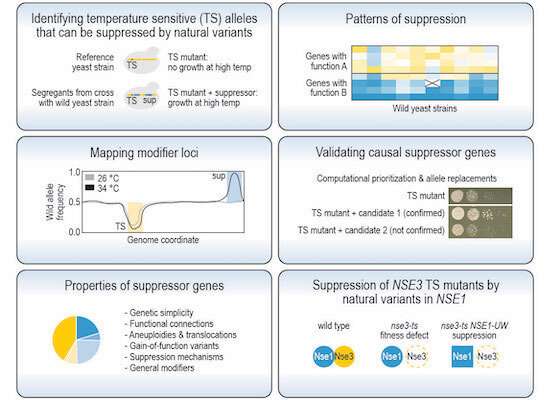'Rescue mutations' that suppress harmful DNA changes could shed light on origins of genetic disorders

New insights into the ability of DNA to overcome harmful genetic changes have been discovered by scientists at the Wellcome Sanger Institute, the University of Lausanne and their collaborators. The team found that 26 percent of harmful mutations were suppressed by naturally occurring variants in at least one wild yeast strain. In each instance examined in detail, a single 'rescue mutation' was responsible for canceling out another mutation that would have threatened the organism's survival.
The study, published today (27 May 2021) in Molecular Systems Biology, provides important information about how DNA variants can suppress undesirable genetic changes. If confirmed in humans, this biological phenomenon could have an important role in genetic diseases such as cancer or rare developmental disorders, and explain why certain patients suffer from more severe disease than others.
Mutations are changes to the letters of DNA that form the genetic code of multi-cellular organisms. They can be a result of errors when DNA replicates during cell division, or the influence of environmental exposures such as ultraviolet light. While most mutations will have no significant effect on how the cell functions, some can be harmful and lead to genetic diseases such as cancer. Other mutations can be beneficial and contribute to genetic diversity in a species through the natural process of evolution1.
With six billion letters of DNA in the human genome, the implications of natural genetic variation are vast. As a result, the precise effect of mutations on the function of genes and cells is not fully understood. Mutations that are harmful in one individual may have no negative effect on another. In some cases, this is because the healthy or resilient individuals carry additional mutations, called suppressors, which counteract harmful DNA changes.
In this study, researchers at the University of Toronto screened 1,106 temperature-sensitive alleles2 from 580 essential genes3 in 10 wild yeast strains to see if natural genetic variation would allow the yeast to grow when exposed to an unfavorably high temperature.
They found that 26 percent of the 580 essential genes could be circumvented by natural variants in at least one wild yeast strain. Yeast colonies that continued to grow were then sequenced at the Wellcome Sanger Institute, in order to search for specific mutations that could be suppressing the temperature-sensitive allele.
"The proportion of harmful mutations in essential genes that could be supressed was unexpected, and because we only sampled a small fraction of wild yeast strains the percentage of mutations that can be suppressed by natural variants is likely to be much higher. The frequency of suppression suggests it could make an important contribution in other contexts as well—including, potentially, for human disease," says Professor Jolanda van Leeuwen, a senior author of the paper from the University of Lausanne.
More information: Leopold Parts et al, Natural variants suppress mutations in hundreds of essential genes, Molecular Systems Biology (2021). DOI: 10.15252/msb.202010138
Journal information: Molecular Systems Biology
Provided by Wellcome Trust Sanger Institute




















